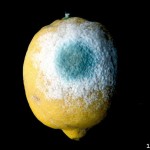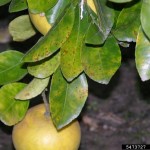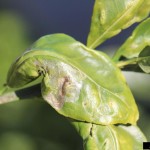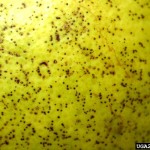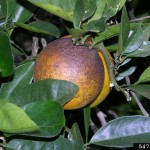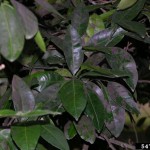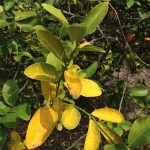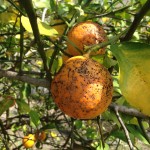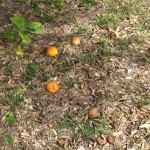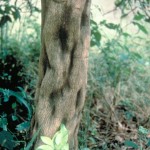Alternaria Stem-End Rot (Black Rot)
|
Fungal pathogen |
Alternaria citri |
|
Area(s) affected |
Fruit |
|
Signs/Symptoms |
Cracks in the stylar end of the fruit, or the bellybutton of the fruit, allow the fungus to enter and infect the fruit. Infected fruit will change color prematurely and may drop early from the tree. A light brown to black spot on the rind can be noticed near the stylar end of the fruit and when the it is sliced open one can observe the black rot inside the fruit. |
|
For more information |
http://www.ipm.ucdavis.edu/PMG/r107100811.html
|
Cachexia (Xyloporosis)
|
Causal agent |
Viroid |
|
Area(s) affected |
Trunks and branches |
|
Signs/Symptoms |
When the bark is peeled back one can observe smooth depressions in the wood which correspond to projections extending from the inner bark. |
|
For more information |
https://edis.ifas.ufl.edu/cg037
|
Citrus Greening (Huanglongbing)
|
Bacterial pathogen |
Candidatus Liberibacter spp. |
|
Area(s) affected |
Entire tree |
|
Signs/Symptoms |
Infected trees may decline and eventually die. Fruit maybe small and lopsided. Irregular patterns of dark green, light green and yellow blotches (mottling) cross the veins of leaves and are asymmetrically displayed on the leaf blade. Infected leaves may be thicker and leathery compared to healthy leaves. 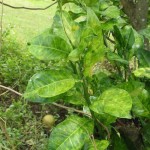 Photo credit: Florida Division of Plant Industry Archive, Florida Department of Agriculture and Consumer Services, Bugwood.org
|
|
For more information |
https://idtools.org/tools/5/index.cfm?packageID=2&entityID=173 |
Citrus Tatter Leaf
|
Causal agent |
Citrus tatter leaf capillovirus, (syn. Citrange stunt virus) |
|
Area(s) affected |
Entire tree |
|
Signs/Symptoms |
Infected plants are usually symptomless. However, when symptoms are produced, one can observe leaf yellowing, leaf deformation, twig deformation, stunting, overblooming, and premature fruit drop. This virus also causes a bud-union crease, which can be seen when the bark is peeled back. One can observe a yellow to brown line where the scion and stock were grafted together. |
|
For more information |
https://iocv.ucr.edu/citrus-diseases/citrus-tatter-leaf
|
Cotton Root Rot
|
Fungal pathogen |
Phymatotrichopsis omnivora, (syn. Phymatotrichum omnivorum) |
|
Area(s) affected |
Roots |
|
Signs/Symptoms |
Infected plants die suddenly. Root bark is decayed and brownish, and bronze colored wooly strands of the fungus are frequently apparent on the root surface. Leaves will turn brown and remain attached to the branches. |
|
For more information |
http://pods.dasnr.okstate.edu/docushare/dsweb/Get/Document-2321/EPP-7621web.pdf
|
Diplodia Stem-End Rot
|
Fungal pathogen |
Diplodia natalensis, (syn. Physalospora rhodina) |
|
Area(s) affected |
Fruit |
|
Signs/Symptoms |
This disease remains dormant while the fruit is still attached to the tree. Once the fruit is removed and put into storage, symptoms will be produced. The rind will first turn brown near the stem end of the fruit and then will progress down the fruit forming brown, finger-like streaks. The whole fruit will eventually turn black and give off a sour, fermented odor. |
|
For more information |
|
Exocortis
|
Causal agent |
Citrus exocortis viroid (CEVd) |
|
Area(s) affected |
Rootstock |
|
Signs/Symptoms |
Infected rootstocks will be stunted and the bark at the crown of the tree will peel off, this is known as bark shelling. A gummy substance may also exude from the base of the trunk. |
|
For more information |
Flyspeck
|
Fungal pathogen |
Leptothyrium pomi |
|
Area(s) affected |
Fruit |
|
Signs/Symptoms |
Small black dots form on the rind near the oil glands. This causes the affected area to remain green when the fruit matures, or turns yellow. This does not affect the fruit or juice quality, only the fruit grade. |
|
For more information |
http://aggie-horticulture.tamu.edu/citrus/l2316a.htm
|
Green Mold
|
Fungal pathogen |
Penicillium digitatum |
|
Area(s) affected |
Fruit |
|
Signs/Symptoms |
Fruit injured during harvesting and handling may be infected by this fungus. The fungus enters the fruit only through wounds in the rind and these wounds soon turn to water soaked lesions. A white substance eventually forms on the lesion and as the lesion gets larger, the center will turn olive green and be outlined in white.
|
|
For more information |
https://edis.ifas.ufl.edu/publication/CH081
|
Greasy Spot
|
Fungal pathogen |
Mycosphaerella citri |
|
Area(s) affected |
Leaves and fruit |
|
Signs/Symptoms |
Yellow to dark brown to black spots form on the underside of the leaf. As these spots darken, corresponding yellow spots will form on the upper leaf surface. Leaves may drop prematurely. If the fruit is infected, small black spots will form on the rind and the surrounding area will remain green longer.
|
|
For more information |
http://edis.ifas.ufl.edu/hs263
|
Heart Rot/Wood Rot
|
Fungal pathogen(s) |
Ganoderma spp. |
|
Area(s) affected |
Trunk |
|
Signs/Symptoms |
At the base of infected trunks, brown to reddish-brown, fan-shaped structures can be observed. This infection causes internal wood rot and the affected tree will eventually decline or die. |
|
For more information |
http://edis.ifas.ufl.edu/hs269
|
Citrus Leafminer
|
Pest |
Phyllocnistis citrella |
|
Area(s) affected |
Leaves |
|
Damage |
Females lay larvae singly on the underside of the leaf. After the larvae hatch they begin to feed in shallow, serpent-like tunnels in the leaves. The tunnels are filled with frass, or excrement. Affected leaves will curl and be distorted.
|
|
For more information |
Melanose
|
Fungal pathogen |
Diaporthe citri |
|
Area(s) affected |
Leaves and fruit |
|
Signs/Symptoms |
Small, brown spots surrounded by a yellow halo form on the leaf surface. As the disease progresses, a gummy substance exudes from the spot, dries, hardens, and gives the leaf a sandpaper texture. Leaves may drop prematurely. Small, brown to black raised spots form on the fruit surface. If these spots coalesce they form an irregular, cracked pattern known as “mudcake melanose.” Sometimes these spots develop in a tear-streaked pattern known as “tear-stain melanose.”
|
|
For more information |
https://idtools.org/tools/5/index.cfm?packageID=2&entityID=178 |
Physiological Disorders
|
Causal agent(s) |
Wind, strong sunlight, nutrient deficiencies, herbicide toxicity |
|
Area(s) affected |
Leaves and fruit |
|
|
Firing: wind desiccation Leaf Yellowing: Magnesium, iron or zinc deficiencies and herbicide injury. Oleocellosis: Peel oil is released when rind cells have been injured as a result of abrasion or rough handling. Sunken spots form on the rind. Spray Burn: The fruit has a dry, brown sunken spot. Sunscald: When the undersides of leaves are exposed to direct sunlight, irregular, brown, raised spots may be observed. Wind Scar: This damage occurs as the result of twigs or leaves rubbing against young fruit |
|
For more information |
|
Phytophthora Diseases
|
Fungal pathogen(s) |
Phytophthora citrophthora, P. parasitica, and other Pytophthora spp. |
|
Area(s) affected |
Fruit, roots, and trunk |
|
Signs/Symptoms |
Brown Rot: The low-hanging fruit become infected first and then water will disseminate the fungus to fruit higher in the tree. Light brown lesions will form on the rind. As the disease progresses, in humid conditions, a white velvety growth can be observed on the rind and the fruit will give off a pungent, rancid odor. Feeder Root Rot: The fungus infects the cortex of feeder roots, giving the root system a stringy appearance. This can lead to yield loss and a general prolonged tree decline. Foot Rot/Gummosis: Infection of the trunk results in a dark, water-soaked areas, often with profuse exudation of a dark resin from the lesion. The dead bark frequently sloughs off the wood in vertical strips. If the lesion encircles the trunk, girdling occurs, leading to the death of the tree. |
|
For more information |
http://www.ipm.ucdavis.edu/PMG/r107100111.html |
Rio Grande Gummosis
|
Fungal pathogen |
Physalospora rhodina, (syn. Diplodia natalensis) and several other factors |
|
Area(s) affected |
Trunk and branches |
|
Signs/Symptoms |
Blisters on the trunk exude a pale yellow, gummy substance. The wood beneath infected tissue is pink to orange in color. Gum pockets may form. |
|
For more information |
http://aggie-horticulture.tamu.edu/citrus/l2313.htm http://www.ivia.es/iocv/enfermedades/Rio_Grande_Gummosis/Rio_Grande_Gummosis.htm |
Citrus Rust Mite (Silver Mite)
|
Pest |
Phyllocoptruta oleivora |
|
Area(s) affected |
Fruit |
|
Signs/Symptoms |
Mites feed on the fruit destroying the rind cells. When the fruit is green destroyed cells turn black (“bronzing”) and when the fruit is mature destroyed cells turn rust brown and are rough to the touch (“sharkskin”).
|
|
For more information |
Psorosis (Scaly Bark)
|
Causal agent |
Citrus psorosis virus |
|
Area(s) affected |
Entire tree |
|
Signs/Symptoms |
Leaves may exhibit yellow irregular flecks, blotches or round spots. Fruit may exhibit a yellow ring shaped pattern on the rind. Trunk and limbs will exhibit bark scaling or flaking, where the bark sloughs off. A gummy substance may form around the bark lesions, impregnating the wood, eventually leading to the rapid decline of the tree. The tree will become unproductive. |
|
For more information |
https://idtools.org/tools/5/index.cfm?packageID=2&entityID=182 |
Slow Decline
|
Causal agent |
Tylenchulus semipenetrans |
|
Area(s) affected |
Entire tree |
|
Signs/Symptoms |
The nematode feeds on the roots causing aboveground symptoms: canopy thinning, lack of vigor, poor fruit production, small leaf and fruit size, and exposure of bare crown limbs. |
|
For more information |
Sooty Mold
|
Fungal pathogen |
Capnodium spp. |
|
Area(s) affected |
Leaves, fruit and branches |
|
Signs/Symptoms |
Leaves, fruit and sometimes branches have a black, moldy appearance. The fungi causing sooty mold do not actually infect the plant, instead they grow on the sugary exudates (honeydew) of insects such as aphids, brown soft scale, blackflies and whiteflies. This can cause premature leaf drop and stunting of the tree.
|
|
For more information |
Sweet Orange Scab (SOS)
|
Fungal pathogen |
Elsinoe australis |
|
Area(s) affected |
Fruit |
|
Signs/Symptoms |
Tan to gray, corky, wart-like scabs will form on the fruit rind.
|
|
For more information |
https://idtools.org/tools/5/index.cfm?packageID=2&entityID=184 |
Tristeza (Quick Decline)
|
Causal agent |
Citrus tristeza virus |
|
Area(s) affected |
Entire tree |
|
Signs/Symptoms |
The symptoms produced depend on the variety of plant, environmental conditions, and the virus strain. The virus can cause the tree to decline, leading to tree death. There are three distinct syndromes of the disease: quick decline, stem pitting, and seedling yellows. Leaves will exhibit yellow flecking, leaf cupping, and light green to yellow leaf veins. Fruit quality and size will be reduced. Branches and trunks will exhibit pitting, and if it is serious they will take on a ropey appearance.
|
|
For more information |
https://idtools.org/tools/5/index.cfm?packageID=2&entityID=185 |
Twig Dieback
|
Fungal pathogen |
various fungi, as well as other factors |
|
Area(s) affected |
Branches |
|
Signs/Symptoms |
Fungal infection often occurs following a freeze or mechanical or chemical injury. Affected young branches die back from the tip, sometimes producing gum exudation. Wood discoloration under the bark maybe observed. |
|
For more information |
|
For additional support and current disease management information, contact your local AgriLife Extension Office: http://counties.agrilife.org/
Content editor: Corinne Rhodes, Undergraduate Extension Assistant, Texas Plant Disease Diagnostic Laboratory. This project was performed to satisfy BESC485 requirement under the supervision of Dr. Kevin Ong, kevo@tamu.edu, Director, Texas Plant Disease Diagnostic Laboratory, Texas A&M University, Texas AgriLife Extension Service (April 25, 2014)
